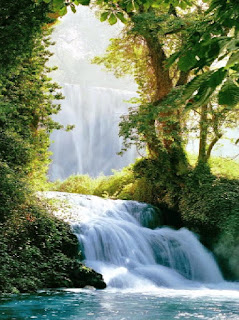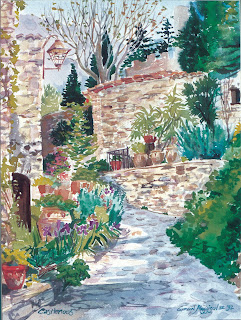
 I like building my scenes slowly. Some may think I am too timid, but I want to make sure I insure that the whites are reserved in all their luminous shades.It's the way light actually bends and moves through objects in space, so the light seems to actually be on the painting itself. Here is how I do it, in this case a Waterfall Demo at Reddi Arts one of my teaching venues.
I like building my scenes slowly. Some may think I am too timid, but I want to make sure I insure that the whites are reserved in all their luminous shades.It's the way light actually bends and moves through objects in space, so the light seems to actually be on the painting itself. Here is how I do it, in this case a Waterfall Demo at Reddi Arts one of my teaching venues.
As you can see this initial "ghost" painting (no pencil in my case) is design to both "draw in" and map out the structure and the light. I am not interested in shadows or detail, just light. The background is the most important since in this piece the light is behind the trees.
I slowly add hints of the waterfall and build the wet soft light gradations wet into wet.
Once the water is fleshed out (not fully detailed yet) I move to the yellow of the forest color. This tells me just where the warm light hits the leaves (always the yellow and lights done first).
I build on those yellow colors with my sap greens, olive greens and start moving toward the "cool temperature" greens, the chromes, sage and blue greens for the leaves in shadow.
Not that a series of "light" relationships are established halftones and shadows can be introduced. I mixed up some burnt umber and red and blue to get a more interesting cool shadow. Burnt umber by itself can look a bit dead, so the other two colors in the mix add some luminosity to the shadow by adding a shifting light spectrum within the mix. I gradually move out of the shadow using burnt sienna mixed wet into wet so there is some transition to the light.
I have also taken this moment while the watercolor in the waterfall wash is still slightly moist to add a bit of detail to the aqua colors. By doing this while it is slightly damp it gives the stroke a soft gentler edge, I also add some light purple shadows in the shadow areas.
I keep up this method building detail with a color related to the burnt sienna, raw sienna, a more golden light, because the leaves closer to the light would have more yellow than blue (the cool/warm on the color wheel concept). Always be cognizant of what the temperature of your place is in the picture.
Above you can see I am starting only now to move deeper into the cooler shadow greens with cerulean and chrome, sometimes olives. I worked a bit to try to keep an interesting aqua edge to the waterfall that both had color and softness for the cool spray on the water. Some leafy shadows above are added here with olives and a bit of cerulean.
Last, with a bolder set of multi-color cool blues, and aquas, light thin purple, I do horizontal strokes for the water ripples while there is still some moisture in the paper. If not when you put the light purples in first, then add the cool aquas boldly on top using slightly overlapping strokes in a horizontal fashion. Be cognizant of the glow from the waterfall and the light on the water that must mirror that.
And that's all there is to it!
























































